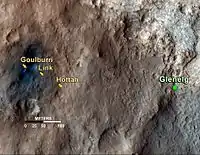Link (Mars)
Link is a rock outcrop on the surface of Aeolis Palus, between Peace Vallis and Aeolis Mons ("Mount Sharp"), in Gale crater on the planet Mars.[1][2][3] The outcrop was encountered by the Curiosity rover on the way from Bradbury Landing to Glenelg Intrigue on September 2, 2012 (the 27th sol of the mission), and was named after a significant rock formation (and lake) in the Northwest Territories of Canada.[4] The "approximate" site coordinates are: 4.59°S 137.44°E.


.jpg.webp) "Link" rock outcrop on Mars - an ancient streambed[1][2][3] viewed by the Curiosity rover (September 2, 2012) (3-D version). | |
| Feature type | Rock outcrop |
|---|---|
| Coordinates | 4.59°S 137.44°E |
The outcrop is a well-sorted gravel conglomerate, containing well-rounded, smooth, abraded pebbles. Pebbles and gravel a few millimeters to centimeters across are embedded in amongst a finer, white matrix. This outcrop geology is strikingly similar to some terrestrial fluvial conglomerates.[5] Around the rock are scattered well sorted loose gravel around 1 cm across, which are thought to be weathering out of the outcrop.
The rock has been interpreted as a cemented fluvial sediment, deposited by a "vigorously" flowing stream, probably between ankle and waist deep. This stream is part of an ancient alluvial fan, which descends from the steep terrain at the rim of Gale crater across its floor.[2]
See also
References
- Brown, Dwayne; Cole, Steve; Webster, Guy; Agle, D.C. (September 27, 2012). "NASA Rover Finds Old Streambed On Martian Surface". NASA. Retrieved September 28, 2012.
- NASA's Curiosity Rover Finds Old Streambed on Mars. NASAtelevision. September 27, 2012. Retrieved September 28, 2012 – via YouTube.
- Chang, Alicia (September 27, 2012). "Mars rover Curiosity finds signs of ancient stream". AP News. Retrieved September 27, 2012.
- "Link to a Watery Past". 26 July 2018. Retrieved March 3, 2021.
- "Rock Outcrops on Mars and Earth". 26 July 2018. Retrieved March 3, 2021.
External links
- Curiosity rover - Official Site
- NASA - Mars Exploration Program
- Volcanic rock classification
- Video (04:32) - Evidence: Water "Vigorously" Flowed On Mars - September, 2012

















.jpg.webp)





